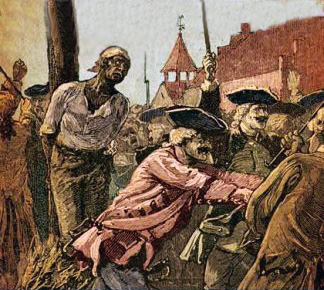
Slave being burned at the stake in N.Y.C. after the 1741 slave insurrection.
New
York’s experience as a slave State is little discussed as is New
England’s role in the infamous slave trade. From the very beginning the
Puritans solved their labor shortage by enslaving Indians – in 1645
Emanuel Downing, John Winthrop’s brother-in-law, hoped that slaves could
be supplied because the colony would never thrive “until we get . . . a
stock of slaves sufficient to do all our business.” Highly recommended
for further reading on this topic is Leon F. Litwack’s “North of
Slavery,” University of Chicago Press, 1961.
Bernhard Thuersam, Chairman
North Carolina War Between the States Sesquicentennial Commission
"Unsurpassed Valor, Courage and Devotion to Liberty"
"The Official Website of the North Carolina WBTS Sesquicentennial"
Empire State Slavocracy
“New
York was slow in drawing white settlers until after mid- [eighteenth]
century, and the shortage of labor led to a considerable use of slaves;
indeed it is possible that in the early Dutch days it was slave labor
that enabled the colony to survive.
Most
of the first slaves were not from Africa but were re-imported from
Curacao in the Dutch West Indies. It was a profitable system: in the
1640’s it cost only a little more to buy a slave than to pay a free
worker’s wages for a year.
After
the English took control of New Netherland in 1664, a brisk and highly
profitable trade in skilled slaves was carried on. Most slaveholders in
the province were flourishing small farmers or small artisans who, in
the absence of an adequate supply of free labor, needed moderately
skilled help, and were able to pay the rising prices for slaves.
A
partial census of 1755 showed . . . most owners having only one or two
slaves, only seven New Yorkers owning ten or more. Among the largest
lots held were those of elder Lewis Morris with 66 slaves on his large
estate and the first Frederick Philipse, an affluent landowner, with
about 40.
William Smith . . . was reputed to keep a domestic staff of
12 or more to run his New York City household, and other citizens
travelled with Negro footmen.
From
the first the competition of black labor was resented by the whites.
Competition in the labor market was intensified by the slave owners’
widespread practice of putting out their slaves for hire, under-cutting
white laborers who were paid twice the slaves’ wages.
Miscegenation,
which began in New York under the Dutch, yielded such a number of
persons of mixed blood in the colony that by the end of the seventeenth
century slave status had to be defined not by color but by the status of
the mother. Some light-colored runaways won freedom by passing into
the white population . . . Yet even under the relatively open system of
slavery that prevailed, family structure was weak and there were a large
number of broken and female-headed families.
The
New York slave, suspended in an awkward equipoise between complete
bondage and half-freedom, was often restive. After 1702, flogging was
prescribed if three slaves gathered together on their own time. They
were not permitted to gamble or to buy liquor . . . nor could they
engage in trade without their masters’ consent.
Fires
were a frightening problem in the eighteenth-century towns and blacks
were commonly suspected of arson . . . [and the] penalty for committing
arson was death. The killing of a white person by a black was punished
by torture followed by execution, a sentence that courts did not
hesitate to impose.”

No comments:
Post a Comment